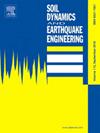Mechanical properties and safety analysis of rack railways under seismic loads with different connection methods
IF 4.2
2区 工程技术
Q1 ENGINEERING, GEOLOGICAL
引用次数: 0
Abstract
Rack railways are essential for mountainous railway transportation because of their ability to navigate steep slopes. However, in the tectonically active southwestern mountainous region of China, which is characterized by extensive fault zones, the behavior of rack systems on bridges under seismic loads has not been thoroughly studied. Here, this gap is addressed by developing a dynamic model of the vehicle–track–bridge system under seismic loading via train–track–bridge interaction theory. The mechanical properties of rack systems with both rigid and elastic connection methods are examined in this study, with a focus on key parameters such as rack tensile stress, shear stress, lateral torque, and bolt shear stress under varying dynamic loads. Rigid connections exhibit greater stiffness, leading to stress concentrations under coupled seismic and vehicle loads. This stiffness results in stress concentrations near bridge bearings, in which the maximum tensile stress, shear stress, and lateral torque reach 242 MPa, 226 MPa, and 2380 N m, respectively. Moreover, the maximum bolt shear stress reached 222 MPa, surpassing the shear and bending strength thresholds, further indicating a risk of localized structural failure. Conversely, elastic connections, with their buffering effects, effectively reduce stress concentrations. The maximum tensile stress, shear stress, lateral torque, and bolt shear stress were reduced to 68 MPa, 147 MPa, 1630 N m, and 120 MPa, respectively, which are all within safety limits. These findings demonstrate that elastic connections enhance the stability and safety of rack railway systems on bridges under seismic conditions. The aim of this study is to provide a theoretical basis for the design and safety assessment of rack railways on bridges in mountainous regions.
求助全文
约1分钟内获得全文
求助全文
来源期刊

Soil Dynamics and Earthquake Engineering
工程技术-地球科学综合
CiteScore
7.50
自引率
15.00%
发文量
446
审稿时长
8 months
期刊介绍:
The journal aims to encourage and enhance the role of mechanics and other disciplines as they relate to earthquake engineering by providing opportunities for the publication of the work of applied mathematicians, engineers and other applied scientists involved in solving problems closely related to the field of earthquake engineering and geotechnical earthquake engineering.
Emphasis is placed on new concepts and techniques, but case histories will also be published if they enhance the presentation and understanding of new technical concepts.
 求助内容:
求助内容: 应助结果提醒方式:
应助结果提醒方式:


